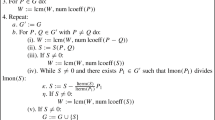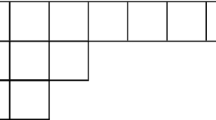Summary
Here is an improvement on Masser's Refined Identity (D. W. Masser:A vanishing theorem for power series. Invent. Math.67 (1982), 275–296). The present method depends on a result from differential algebra andp-adic analysis. The investigation from the viewpoint ofp-adic analysis makes the proof clearer and, in particular, it is possible to exclude the concept of “density” which is necessary in Masser's treatment. That is to say, the theorem will be stated as follows: Let Ω = (ω ij ) be a nonsingular matrix inM n (ℤ) with no roots of unity as eigenvalue. LetP(z) be a nonzero polynomial inC[z],z = (z 1,⋯,z n ). Letx = (x 1,⋯,x n ) be an element ofC n withx i ≠ 0 for eachi. Define
. IfP(Ωk x) = 0 for infinitely many positive integersk, thenx 1,⋯,x n are multiplicatively dependent.
To prove this, the following fact on elementary functions will be needed: LetK be an ordinary differential field andC be its field of constants. LetR be a differential field extension ofK andu 1,⋯,u m be elements ofR such that the field of constants ofR is the same asC and for eachi the field extensionK i =K(u 1,⋯,u i ) ofK is a differential one such thatu′ i =t′ i−1 u i for somet i−1∈K i−1 oru i is algebraic overK i−1. Letf 1,⋯,f n ∈R be distinct elements moduloC and suppose that for eachi there is a nonzeroe i ∈R withe′ i =f′ i e i . Thene 1,⋯,e n are linearly independent overK.
Similar content being viewed by others
References
Ax, J.,On Schanuel's conjectures. Annals of Math.93 (1971), 252–268.
Cassels, J. W. S.,An embedding theorem for fields. Bull. Austral. Math. Soc.14 (1976), 193–198.
Koblitz, N.,p-adic numbers, p-adic analysis and zeta-functions (2nd ed. (Graduate Texts in Math. Vol. 58). Springer, New York and Berlin, 1984.
Kolchin, E. R.,Algebraic groups and algebraic dependence. Amer. J. Math.90 (1968), 1151–1164.
Masser, D. W.,A vanishing theorem for power series. Invent. Math.67 (1982), 275–296.
Rosenlicht, M.,On Liouville's theory of elementary functions. Pacific J. Math.65 (1976), 485–492.
Rosenlicht, M. andSinger, M.,On elementary, generalized elementary and Liouvillian extension fields. InContributions to Algebra, Bass, Cassidy, Kovacic eds., Academic Press, New York, 1977, pp. 329–342.
Author information
Authors and Affiliations
Rights and permissions
About this article
Cite this article
Nishioka, K., Nishioka, K. Algebraic independence of elementary functions and its application to Masser's vanishing theorem. Aeq. Math. 40, 67–77 (1990). https://doi.org/10.1007/BF02112281
Received:
Accepted:
Issue Date:
DOI: https://doi.org/10.1007/BF02112281




